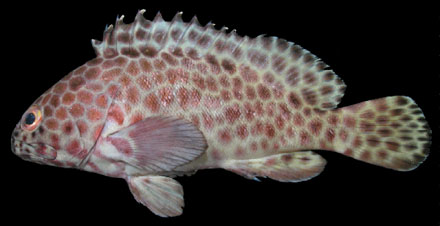
Epinephelus quoyanus, FRLM 30635, 18.4 cm SL
Epinephelus quoyanus (Valenciennes, 1830)
Longfin grouper
|
|
D XI, 16 - 18; A III, 8; P1 16 - 19; LLp 48 - 52; GR 6 - 8 + 14 - 16. Body depth 2.8 - 3.2 in SL; dorsal profile of head convex; snout short; serrae at corner of preopercle enlarged. Caudal fin rounded; pectoral fins long, 1.2 - 1.6 in head; pelvic fins not reaching or just reaching anus. Scales on body ctenoid except anterodorsally above lateral line, on thorax, and abdomen; scales on nape very small; maxilla naked or with a few very small scales. Color: whitish with numerous large close-set hexagonal or roundish dark brown to black spots on body and head, the spots being close together dorsally, so the pale interspaces forming a reticulum, but ventrally the spots more separated and their margins more diffuse; similar dark spots on median fins; spots on head progressively smaller anteriorly; chest with 2 dark brown bands joining below pectoral fin bases; ventral edge of anal and caudal fins and leading edge of pelvic fins with white line and blackish submarginal band; pectoral fins mostly dusky with faint dark spots. Size: maximum length about 40 cm. Distribution: Western Pacific: southern Japan to tropical coast of Australia. Unknown from the Indian Ocean except for the Andaman Islands. Remarks: often misidentified as E. macrospilos or E. hexagonatus. Inhabits inshore silty reefs; there are no records from depths greater than 50 m. Feeds on crustaceans, fishes, and worms. The enlarged fleshy pectoral fins appear to have resulted from its habit of sitting on the substrate.
|

 
|
|
